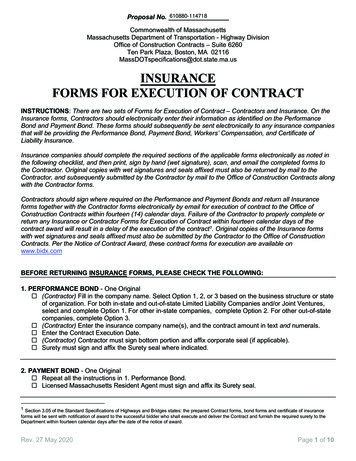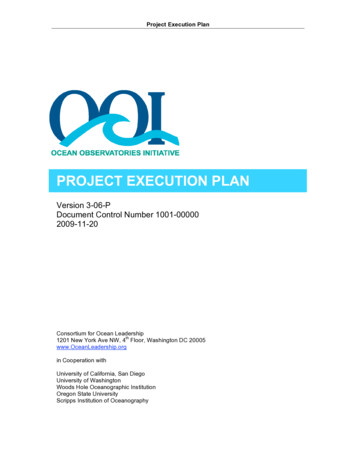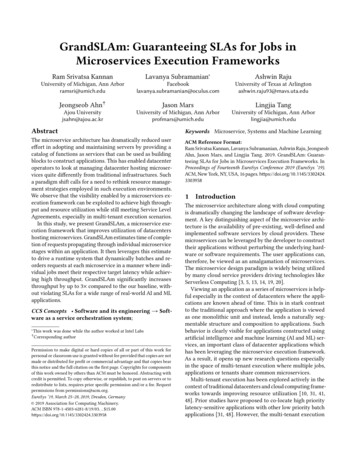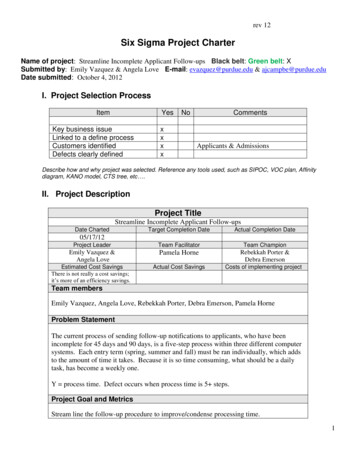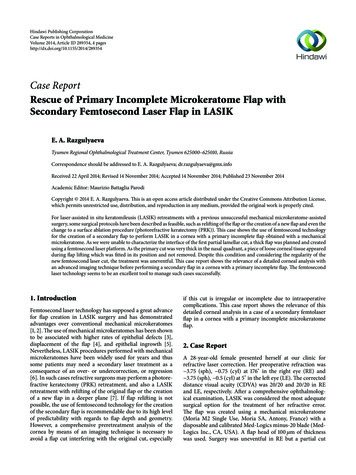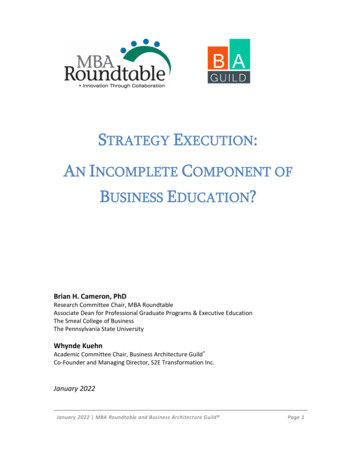
Transcription
STRATEGY EXECUTION:AN INCOMPLETE COMPONENT OFBUSINESS EDUCATION?Brian H. Cameron, PhDResearch Committee Chair, MBA RoundtableAssociate Dean for Professional Graduate Programs & Executive EducationThe Smeal College of BusinessThe Pennsylvania State UniversityWhynde KuehnAcademic Committee Chair, Business Architecture Guild Co‐Founder and Managing Director, S2E Transformation Inc.January 2022January 2022 MBA Roundtable and Business Architecture Guild Page 1
Strategy Execution: A Missing Component of Business Education?STRATEGY ALIGNMENT – THE ELUSIVE HOLY GRAILIn their book “The Balanced Scorecard: Translating Strategy into Action”i , authors Robert Kaplan andDavid Norton note that 90 percent of organizations fail to execute their strategies successfully. Theygo on to state that the reason for this failure is often not the strategy itself, but bad execution.According to Norton and Kaplan, this failure to execute is one of the most significant managementchallenges facing public and private organizations in the 21st century.In their 2000 book, "The Strategy‐Focused Organization: How Balanced Scorecard Companies Thrive inthe New Business Environment"ii , Robert Kaplan and David Norton reported that a mere 7 percent ofemployees today fully understand their company's business strategies and what's expected of them inorder to help achieve company goals. Furthermore, in most industries, strategy is not static and istweaked as conditions on the ground change – no plan survives contact with the enemy.How can we hope to successfully execute something that is changing and that a very low percentageof people fully understand? This question is at the heart of the problem – organizations today, for themost part, are no better at executing their business strategies than they were twenty years ago.We’ve seen decades of research and teaching in the area of strategy execution yet little improvementin our ability to execute business strategy.The MBA Roundtable and Business Architecture Guild have partnered to better understand how thetopic of strategy execution is approached in graduate business education today and suggest possiblereasons why strategy execution remains elusive in many organizations.OVERVIEW OF THE STUDY AND FINDINGSThe MBA Roundtable and Business Architecture Guild developed a short survey designed to betterunderstand how strategy execution is taught in business graduate programs. This survey was sent toadministrative leads of graduate programs from a broad cross section of colleges and universities, andseventy‐eight responses were received.The main focus of the survey was to learn (a) if strategy execution was taught as a required componentof business graduate programs and, if so, (b) how strategy execution was taught in these programs andthe associated topics covered.The main part of the survey asked “Do any of your professional master’s programs and/or MBAprograms offer a course on strategy execution?” For those that answered Yes, the survey then asked“Is the course required or an elective in your professional master’s and MBA programs?” The surveythen asked the respondent to upload an outline of the topics covered and/or a copy of the coursesyllabus. A total of thirty‐eight syllabi were submitted. This paper focuses on the findings from thesubmitted syllabi.January 2022 MBA Roundtable and Business Architecture Guild Page 2
Strategy Execution: A Missing Component of Business Education?The thirty‐eight syllabi came from a variety of colleges and universities. Most of the schools in thisgroup were U.S.‐based institutions (36) with two from Canada with a fairly even mix of public andprivate schools (22 public, 16 private). There was also a fairly even mix of large universities and smalland mid‐sized schools (17 large universities, 21 small/mid‐sized schools). Even though all submittedsyllabi claimed to be strategy execution courses, only four had strategy execution/implementation inthe title of the course.The remainder of this article discusses the findings from those schools that reported to offer a requiredstrategy execution course in their professional master’s and/or MBA programs and were willing toshare an outline of the course or a course syllabus.Strategic Management CoursesThe vast majority (33) of the course syllabi were strategic management related courses. These coursesgenerally focused on topics such as understanding business strategy, components of business strategy,corporate governance, strategic leadership, mergers and acquisition strategies, competitive analysis,organizational analysis, environmental analysis, strategy development, innovation, changemanagement, conflict management, team dynamics, ethics, and other related topics.Only ten of these courses, however, listed strategy execution/implementation as a module in thesyllabus. Eight of these courses devoted one week (2‐3 class hours) to the topic and one of the coursesdevoted two weeks to the topic and one course devoted three weeks to strategyexecution/implementation. These courses typically focused on topics such as organizational cultureand structure, change management, team dynamics, rewards and incentives, power and influence, andeffective communications during this one‐to‐two‐week period.All courses heavily utilized a variety of case studies (32) with six also utilizing simulation. Of the coursesthat utilized simulations, all but one used the CAPSIM simulation. In this simulation, each team ofstudents runs a simulated company and make strategic decisions to attempt to out‐compete the otherteams over a simulated multi‐year period.Besides traditional strategic management course titles, a variety of other course titles were submittedthat include Strategic Leadership (3), Business Policy/Policy & Strategy (3), Corporate/BusinessStrategy (3), Integrated Business Capstone (1), International Business Strategy (1), and Strategy in theMusic Industry (1). These courses were generally strategic management related courses with moreemphasis in certain areas and most utilized a strategic management textbook.Strategy Execution/Implementation CoursesFour of the submitted courses had Strategy Execution/Implementation in the title of the course.These courses focused heavily on the human and organizational elements of strategy implementation– managing people, resistance to change, building effective teams, navigating/understanding politics,types of power, change management strategies, importance of communication, organizationalstructure, information and decision processes, rewards, people, and leading change without formalauthority.January 2022 MBA Roundtable and Business Architecture Guild Page 3
Strategy Execution: A Missing Component of Business Education?Two of the four courses heavily referenced the McKinsey 7‐S framework for organizational alignment,as shown in Figure 1. Other similar models, such as the Star Model , were also referenced in some ofthe courses.Figure 1: McKinsey 7‐S FrameworkAll courses in this group heavily utilized case studies and one utilized the CAPSIM simulation. Thesecourses were almost entirely case study based.Other Courses SubmittedOne course focused on the practice of leveraging business architecture as a facilitator of strategyexecution. The main focus of this course was the use of a process that utilizes different businessblueprints and modeling techniques to inform business strategy development and link businessstrategy with tactical execution in the form of projects and project portfolios and the on‐goingmanagement and alignment of those project portfolios with changes in the business strategy. Theprocess of leveraging business architecture keeps the project portfolios in alignment with changes inbusiness strategy and business priorities.A few smaller case studies were utilized in this course to illustrate concepts but the majority of theemphasis was the application of the business architecture process and associated modeling techniquesto real‐world strategy execution issues within the students’ organizations. This was done using a seriesof team and individual projects that were design to build upon one another as the course progressed.The audience included working professionals taking this course as part of an online master’s program.January 2022 MBA Roundtable and Business Architecture Guild Page 4
Strategy Execution: A Missing Component of Business Education?SUMMARYAccording to Michael Porter and other recognized experts, strategy execution is a major issue for alltypes of organizations today. Also, it appears that there have not been significant improvements inthe ability of organizations to successfully execute strategy. This analysis suggests several possiblecontributing factors to this problem:Only Part of the Problem is CoveredMost of the courses in this analysis covered strategic management and leadership topics and onlyfocused one or two weeks to strategy execution/implementation and focused on topics such asorganizational culture and structure, change management, team dynamics, rewards and incentives,power and influence, and effective communications. These topics were often discussed in the contextof case studies.While these topics are important contributors to strategy execution, they do not explain the details ofHOW to perform strategy execution comprehensively and how to link the execution layer (projects)with business strategy and ongoing changes to business strategy. Without this linkage, the execution(project) layer falls out of alignment with strategy.Strategy Execution Courses Don’t Go Deep EnoughAs stated previously, the courses with strategy execution/implementation in their titles focused heavilyon the human and organizational elements of strategy implementation – managing people, resistanceto change, building effective teams, navigating/understanding politics, types of power, changemanagement strategies, importance of communication, organizational structure, information anddecision processes, rewards, people, and leading change without formal authority. These topics weretaught by the use of case studies that focus on one or more of these areas.While these topics are important for successful strategy execution, they are far from thecomprehensive set of skills, knowledge, and processes needed for successful strategy execution. Noneof these courses discuss HOW to link the execution layer (projects) with business strategy and manageongoing changes to business strategy. None of the cases used focus on this critical aspect of strategyexecution.The case teaching method is effective at a higher, conceptual level and tends to address the WHAT andWHY well but often does not provide many details on the HOW which is often context/organizationspecific. In addition, cases rarely give the students the opportunity to model and explore their ownorganization and problems and get hands‐on experience with the details of the HOW component ofstrategy execution.Business Architecture Offers a Needed ComplementThis analysis suggests that an incomplete strategy execution picture is presented in many businesscurriculums today. This incomplete picture could be a contributing factor to the persistent problem ofstrategy execution seen in many organizations currently. The discipline of business architecture offersa potential complement to traditionally taught strategy execution related topics. In order to furtherJanuary 2022 MBA Roundtable and Business Architecture Guild Page 5
Strategy Execution: A Missing Component of Business Education?evaluate the potential of business architecture as an enabler in strategy execution education, it isnecessary to understand the foundational elements of business architecture.Overview of Business ArchitectureBusiness architecture is an evolving discipline that has its roots in enterprise architecture and ITstrategic planning. The discipline has evolved substantially and become more formalized over the lastdecade. Business architecture has moved from its roots in enterprise architecture to now beingpracticed as a more strategic discipline, reporting to a business function in many organizations. TheBusiness Architecture Guild recognizes ten domains of business architecture that represent thebusiness ecosystem as shown in Figure 2.Figure 2: Business Architecture DomainsAt a very high level, the process of leveraging business architecture to align strategy and executionincludes: Understanding your organization’s business model and operating model.Understanding your organization's actionable business strategy and target outcomes.Understanding the market trends impacting your business and the business strategy.Identifying how the organization delivers value and the business capabilities that are requiredto support the business as well as the impact on people, processes, information, andtechnology.Creating deliverables that can be used to drive business case analysis, investment selectionand prioritization, shape initiatives, etc.Business architecture aims to consolidate and maintain a conceptual, multidimensional view of anorganization in order to better define what the organization does and what it needs to do to meet itsgoals and facilitate strategy execution through effective project‐level execution that is aligned withbusiness strategy and changes in strategy. Value streams and capabilities form the foundation of aJanuary 2022 MBA Roundtable and Business Architecture Guild Page 6
Strategy Execution: A Missing Component of Business Education?business architecture. As shown in Figure 3, capabilities are central for connecting and informing otherbusiness architecture components and are the bridge that connects project level execution withstrategy (and changes in strategy). Strategic portfolio management is critical to effective strategyexecution and provides the governance needed to effectively manage project portfolios as well asother asset portfolios such as capability and process portfolios.Figure 3: Key Business Architecture Components and Their InterrelationshipsiiiBusiness Architecture is an established practice in many leading organizations today. Successfulstrategy execution requires collaboration and integration across closely related disciplines/teams fromstrategic planning to portfolio management to business analysis. Business architecture and businessarchitects not only play a unique role to help inform, articulate, and translate strategy, but also to helpbring these teams together around a common understanding of that future‐state vision with clearcoordination points. Leading organizations leverage business architecture not only to articulate anddetail their business strategy, but also to translate it into guidance that drives business and IT executiontoward the future‐state vision.As Figure 4 suggests, if the business architecture practice is positioned correctly in the organizationand staffed appropriately, it could become a critical input into the formulation of effective corporatestrategy that is actionable and executable.January 2022 MBA Roundtable and Business Architecture Guild Page 7
Strategy Execution: A Missing Component of Business Education?Figure 4: Business Architecture’s Role in Strategy Formulation and ExecutionivBusiness Architecture can be the linchpin to bridge business strategy with project‐level execution. Thisis the bridge that is missing or not functioning well in many organizations today and is the criticalcomponent to successfully aligning initiatives with business direction.NEXT STEPSThe findings of this study suggest that (a) strategy execution is often taught in a cursory manner ingraduate business curriculums and when a strategy execution/implementation related course isoffered, it is often taught at a high‐level with a focus on the human and organizational elements ofstrategy implementation, and (b) the discipline of business architecture offers a needed complementto strategy execution/implementation education and addresses a hole in graduate businesscurriculums.The MBA Roundtable and Business Architecture Guild plan to develop future white papers andwebinars that further explore the possibilities that business architecture brings to graduate businesseducation and best practices for teaching and integrating business architecture into graduate businesscourses and curriculums.January 2022 MBA Roundtable and Business Architecture Guild Page 8
Strategy Execution: A Missing Component of Business Education?About the MBA RoundtableThe MBA Roundtable is a global association of business schools whose mission is to advance graduatemanagement education through curricular and co‐curricular innovation. For more information, pleasevisit: https://www.mbaroundtable.org/.About the Business Architecture Guild The Business Architecture Guild is a global not‐for‐profit association whose mission is to promote bestpractices and expand the knowledgebase of the business architecture discipline. For moreinformation, please visit: https://www.businessarchitectureguild.org/.iRobert S. Kaplan and David P. Norton, The Balanced Scorecard: Translating Strategy into Action (Boston: Harvard Business SchoolPress, 1996).iiRobert S. Kaplan and D. P. Norton, The Strategy‐Focused Organization: How Balanced Scorecard Companies Thrive in the New BusinessEnvironment (Boston, MA: Harvard Business School Press, 2000).iiiDiagram by Brian H. Cameron and Whynde Kuehn, December 2021.ivDiagram by Whynde Kuehn at: hitecture/faq/ (sourced from “Business Architecture: AKey Enabler for Sustainability Strategy Development and Implementation,” Whynde Kuehn (Melaragno), February 2010).January 2022 MBA Roundtable and Business Architecture Guild Page 9
generally focused on topics such as understanding business strategy, components of business strategy, corporate governance, strategic leadership, mergers and acquisition strategies, competitive analysis, . According to Michael Porter and other recognized experts, strategy execution is a major issue for all types of organizations today. .



